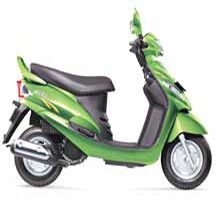Mahindra banks on Peugeot for scooter sales

It may have a stranglehold on the sports utility vehicle market, but Mahindra & Mahindra (M&M) has struggled to get even a toehold in the two-wheeler business. Taking the problem by its scruff, it has now negotiated an agreement with France’s Peugeot Motorcycles in which it will spend out euro 13 million (Rs 100 crore) for a 51 per cent controlling equity.
This is the first major acquisition by M&M after having entered the two-wheeler segment through the acquisition of Kinetic Motor Company in 2008. M&M, however, has been unable to convert the brand popularity earned through its tractors, and the Bolero, Scorpio and XUV5OO SUVs into actual sales for its scooters and motorcycles, despite big discounts, online sales and endorsers from Bollywood. At the end of last year, M&M’s two-wheeler business had accumulated losses of Rs 1,250 crore, leading to an erosion of more than 50 per cent of its peak net worth.
Given that four of the five M&M scooters are rebranded products of the now-defunct Kinetic Motors and the prices of M&M scooters do not differ vastly from that of the Honda Activa, the country's largest selling scooter, it is easy to see why buyers did not take to Mahindra’s offerings.
This is where the acquisition of Peugeot Scooters dovetails into M&M’s aspirations. With a price range starting from where M&M’s current range ends, Peugeot, with its French heritage, will be slotted in the premium end of the market. Peugeot will also bring its prized technology, allowing M&M to take on the Japanese trio of Honda, Yamaha and Suzuki besides home grown companies like Hero and TVS Motors. With a market share of 0.63 per cent and sales of under 14,000 units at the end of September, M&M obviously believes there is a lot of room for growth.
Of the 3.6 million scooters sold last year, more than half, or 1.9 million units, was sold by Honda, according to data provided by the Society of Indian Automobile Manufacturers. The segment witnessed a growth of 23 per cent during the same year. The growth potential is much higher for scooters than for other two-wheelers, especially, as a recent report by Macquarie Research points out, among women buyers. At the moment, women account for 40 of every 1,000 buyers. This number is expected to more than double to 100 per 1,000 buyers.
To meet this demand manufacturers are stepping up investments. Honda is building the world’s largest scooter-only plant in Gujarat with a capacity of 1.2 million units annually, while Hero has plans for two more plants in Gujarat and Andhra Pradesh even as it kick-starts production in Rajasthan.
“The Indian scooter market is growing at 2.5 times the rate at which the overall two-wheeler industry is growing,” says Keita Muramatsu, president & CEO, Honda Motorcycle & Scooter India. “The latent demand for automatic scooters is so strong that we foresee sales going up to 35 per cent of two-wheeler sales in a 5-10-year horizon.”
Peugeot has 13 product lines, seven engine capacities ranging from 50cc to 400cc, and two manufacturing plants, including a joint venture in China. With sales of 79,000 units in 2013, Peugeot's turnover at euro 99 million (Rs 762 crore) was the same as the two-wheeler division of Mahindra, though the Indian company's unit sales at 213,000 units were double those of the French company.
The two companies have agreed to work on four areas: brand building, global expansion, product development and synergies in purchasing. They will remain independent, with no co-badging on products or in sales distribution. “Peugeot brings with it a premium range and a strong European footprint,” says M&M Executive Director Pawan Goenka. “Mahindra facilitates access to the India market, mass market product technology and competence in marketing.”
A Mumbai-based automobiles analyst points out that M&M and Peugeot come from two very different backgrounds and work cultures. “One is focused on mass production, the other on limited-volume premium brand,” he says. “The idea will be to increase volume while keeping the brand intact.”
M&M has had an edgy history partnerships. It had to buy out Renault’s stake in a sedan-making joint venture after failing to make ground. Then it opted out of a tripartite jont venture involving Renault and Nissan for a production facility in Chennai. It also was forced to buy-out its US partner Navistar’s stake in a truck making joint venture.
Goenka says that M&M will treat the Peugeot deal in the same manner as it did the agreement with Korean SUV maker, Ssangyong Motor Company, in which it bought controlling stake in 2010. Ssangyong is run independently by its Korean management but shares platforms and engines with M&M.
Analysts feel that it is Peugeot, more than M&M, that stands to benefit from the deal. Described as a “drag and a burden on the group”, PSA Peugeot Citroen Chief Executive Carlos Tavares had been exploring solutions for its scooter business which has been posting losses for the past decade.
To save the brand and to secure the livelihood of its 800 employees, Peugeot had to scout emerging markets like India and Indonesia where demand for scooters remains high. The partnership with M&M will enable Peugeot to diversify its business base and speed its international expansion by leveraging the strengths of both parties, Peugeot said in a release.
Despite getting three board seats (one more than Peugeot), M&M wants Peugeot’s management to continue steering the company. It will take the next six months for the two companies to work out operations aspects such as products, production and markets, with M&M investing euro 15 million (Rs 115 crore) for product development.

.webp)
.webp)
.webp)
.webp)
.webp)
.webp)
.webp)






